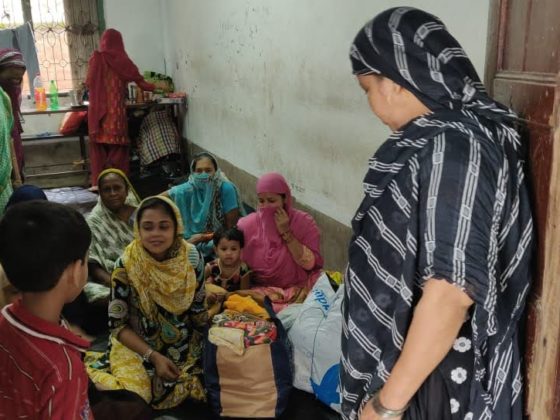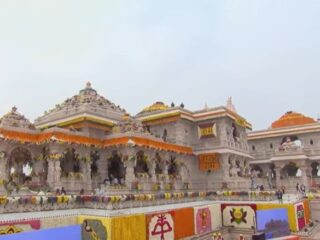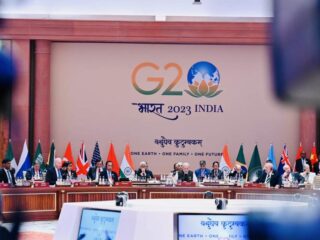(Secular Perspective, June 16 – 30, 2020)
The death of George Floyd in Minneapolis has evoked a sea of responses globally and shook its conscience. Americans from all walks of life irrespective of colour have come out in large protest rallies to condemn racism and police brutality in US. There were some unfortunate instances of looting and violence during these protests but by and large the protests were peaceful, sparking debate and bringing the focus on the deep entrenched systemic racism in the country. George Floyd was 47 years old Black American who died in police custody when police officer, Derek Chauvin knelt over his neck for around nine excruciating minutes even as Floyd gasped for air pleading with the officer to release pressure from his neck, repeating “I cant breathe”. The imagery of George Floyd’s humiliation and inhumane subjugation at the hands of the unrelenting Derek Chauvin in his final moments has shaken the social and moral consciousness of the individuals the world over, calling for condemnation and police reforms against police brutality and excesses. While George Floyd’s death has exposed the long historically existent fault lines based on race, this incident has triggered a discourse on police brutalities which are targeting the vulnerable communities in every country. There are parallels to “George Floyd moments” to be found worldwide. In India, George Floyd’s death unwittingly conjures the imagery of the biased police action against religious minorities especially the Muslims and the Dalits which is starkly marked by prejudice and systemic targeting of these marginalized groups. This prejudice against the Muslims partly stems from and is patronized by the supremacist ideology at helm. Here the author would like to reflect on the striking differences in the responses of Indian state as compared to United States while dealing with police action vis a vis vulnerable groups.
In response to the outrage and decry in the United States by the protestors, the state has come up with a number of proposals to address police brutality. Two most far reaching responses being discussed are, firstly to “defund” the Minneapolis and second is the drastic step to disband the police department force entirely in favor of the new community led safety model (The Tribune , 2020). Defunding of the police department would imply massive budgetary cuts to the police which the protestors believed were disproportionately used against the coloured community and reallocating them to public health, mental health, education and affordable housing for the poor. The Minneapolis City Council has vowed to go as far as disbanding the entire police force something unthinkable in countries today where the idea of security is intimately intertwined with a lethally overreaching armed police force. These sweeping changes underline the recognition of the systemic bias and discrimination that exists in the institution as of now. As against these measures seen in the United States, in India there has been a visible trend of placing the police in the position of extreme power and privilege, even in the face of compelling evidences.
The most recent example is that of Khwaja Yunus. Khwaja Yunus was a young man of 27 years who died in the police custody in 2003. He was a resident of Parbhani in Maharashtra who was arrested for his alleged involvement in the Ghatkopar blasts on December 2, 2002. He was a software engineer arrested with four other accused. While the police claimed that Yunus had escaped from custody, his then co-accused, Dr. Mohammad Matin who was the first prosecution witness before the trial court in January, had submitted that he had seen Yunus being stripped and assaulted on January 6, 2003, following which, he was never seen again. Based on the complaint of Yunus’ co-accused in 2003, an FIR was filed against the policemen (Modak, 2018). Four police officers were prima facie found guilty and suspended from services. However earlier this month they were reinstated. The High Court in 2004 had directed disciplinary enquiry against the four accused. This enquiry was never carried out and instead the four accused police officers were reinstated in contrary to the orders of the High Court.
The ill treatment and torture of the innocent Khwaja Yunus is not a stray incident. Muslim youth are perceived as “natural” suspects in terror attacks reflecting the stigma and demonization of the Muslim community in India. Many innocent Muslim youth are incarcerated under stringent acts like UAPA or POTA and remain in prison for years and released only after years when no evidence is found against them. Mohammed Saleem Ansari, a mechanical engineer was released from jail in 2016 after the Supreme Court absolved him of the terror-related charges under which he had been in prison for 23 long years. Ansari, along with three other Muslims, walked out of a Jaipur jail on May 17 after the Supreme Court on May 11 acquitted them of all charges, setting aside their life sentence and ordering their immediate release. They were among the 16 who were booked for triggering five blasts on trains on the first anniversary of the Babri Masjid demolition, which killed two passengers and injured eight. All of them were charged under the Terrorist and Disruptive Acts Prevention Act (Shaikh, 2016). In another incident, in 2015, Shoaib Khan, 28, from Hingoli, Maulana Mujeeb-ur-Rahman, 30, from Yavatmal and Abdul Malik, 23 from Pusad were arrested by Maharashtra Police and their cases were transferred to Maharashtra’s Anti-Terrorism Squad. In June 2019, they were acquitted of all charges and walked free after a harrowing time in prison. While the media and police painted a picture of radicalization of the Muslim youth in India and alleged that the three were involved in “jihadi” terror acts, Khan narrated a harrowing tale of torture in police custody to extract false statements (Johari, 2019) A 2012 study by the Tata Institute of Social Sciences found that although Muslims account for 10.6 per cent of the Maharashtra population, they comprise over 30 per cent of the prison population. The study observed that the police and intelligence agencies’ bias against Muslims led to a number of arrests under TADA and MCOC Acts, and even the Official Secrets Act.
The common thread running in all these cases is the humiliation and stigmatization that the community faces owing to its religious identity. The years lost in police or judicial custody after undergoing unbearable torture can never be redeemed and are wasted forever. The torture and stigma scars the victims for the rest of their lives. The victimization of Muslim youth in police custody is not a coincidence but one finds a well established pattern of police interface with the Muslim community. This becomes clear in the context of communal riots and mob lynching. There are numerous studies and commission reports which points towards the biased nature of police during communal riots targeting the vulnerable communities. The Srikrishna Commission report (1998) underlines the “built in bias” of the Bombay police force which manifested in the riots in Bombay in 1992 and other places in Maharashtra. The Report of Justice D.P. Madon Commission on Bhiwandi riots (1970) passed severe strictures on the role of police in Bhiwandi riots. On anti-Sikh riots, three inquiry commissions—Justice Rangnath Mishra Commission (1987), Justice Jain-D.K. Agarwal Committee (1990), and Justice R.S. Narula Panal (1994) submitted their reports and all inquiry commissions had unanimously indicted 72 police officers and clearly outline the discriminatory role of the police. Similarly, there are many reports by fact finding committees that give appalling findings on the police’s partisan role in the Gujarat riots of 20021.
In the mob lynching cases that surfaced post 2014, the police is still found wanting at multiple levels- right from protecting the victims from the bloodthirsty mob, to shoddy investigations allowing the perpetrators to walk away free without punishment and to in fact implicate the victims themselves under stringent charges. One can’t erase the image of the police in Hapur escorting the perpetrators who are seen dragging the helpless bleeding victims, Mohammad Qasim and Samiuddin in a hurry (Times of India , 2018). Rakbar Khan in Alwar lost his life due to the fatal casualness of the police who stopped to drink tea for three hours while Rakbar Khan bled to death on the way to the hospital after being lynched by the mob (Goswami & Sharma, 2018). There are many such incidents where the police have proved to be an obstacle in saving innocent lives and delivering justice.
These hair raising incidents must surely compel one to think that inspite of severity and frequency of such incidents, why doesn’t India have the “George Floyd moment” meaning large scale protests or movement on the lines of Black Lives Matter. This is answered with brilliant insight by political scientist Suhas Palshikar who explained that any such protests or voices of dissent are linked to a thriving democracy. The State has steadily delegitimized concern or voices for rights of the marginalized by posing them as threat to order or nation itself (Palshikar, 2020). This carefully constructed narrative has created a barrier for generating empathy in the larger society for the plights of the marginalized no matter how brutally they are violated. This policy is in tandem with the supremacist ideology which hinges on the central idea of constructing a community of second class citizens- the Muslims, Christians, Dalits. Thus while outrage and pain of the protestors reverberated in most of United States where police in some places took to their knee to symbolically acknowledge police excesses and it was their way to offer an apology, the Indian state has most viciously treated protestors.
The recent example was the handling of anti- Citizenship Amendment Act protests by the police. The police have used stun grenades and tear gas on innocent students of Aligarh Muslim University (AMU) which led to serious injuries like loss of sight and loss of limb of some students (The Wire, 2019). This is even as Portland and Seattle have temporarily restricted the use of tear gas on protesters. There was a brutal crackdown on the students of Jamia Millia Islamia in Delhi for which the police came under criticism. The UP police publicly shamed the protestors by putting up their posters and names warning that their property would be attached to recover against damages to public property. The High Court took up this case and observed that the government was “impinging on privacy, respect and freedom” and called it an “illegal move” (NDTV, 2020). One can gauge how inhumanely the police in India deal with protestors going by the arrest of Safoora Zargar, a Jamia Millia Islamia student who is five months pregnant and booked by the Delhi police under the draconian UAPA where she is denied bail. She along with other students was protesting against the National Register of Citizens (NRC) and National Register of Population (NRP) (The New Indian Express, 2020).
After George Floyd’s death, California’s governor ordered the state’s police training program to stop teaching neck holds. Other governments discussed new policies for apprehending suspects to reduce the risk of deadly encounters. These steps are to minimize injuries or deaths to suspects apprehended by police and placed in police custody. Instead of such steps, encounters or extra judicial killings are being used as state policy in Uttar Pradesh. Officials have admitted to over 3,500 police encounters and nearly 80 killings of alleged criminals in a period of over two years, forcing the Supreme Court to intervene (Indian Express, 2019). These encounters have mostly targeted Muslim youth and have made the Muslim community fear for their life and freedom.
These issues highlighted above are directly linked to accountability and democratic institutions. For democratic institutions to thrive and function with fairness, on one hand there must be participatory democracy where people have the freedom to actively and fearlessly participate and on the other hand a state which builds, invests and encourages institution infrastructure. Individuals have to reclaim the public spaces as citizens to express their empathy and outrage at the violations of rights of the marginalized sections of the society. These protests or voices cant be delegitimized by the state. The state has to actively and consciously nurture and reinforce democratic institutions for accountability. While world over there is a growing trend of dismantling of monuments of oppression and slavery, in India the statues of Godse and Manu are worshipped under the present ideology and this is a matter of concern when India is hailed as the largest democracy. Hopefully, India too will take inspiration from the support to George Floyd and redeem its own state and people in favor of liberty, justice and fraternity.
1 https://shodhganga.inflibnet.ac.in/bitstream/10603/40546/13/16_chapter7.pdf







